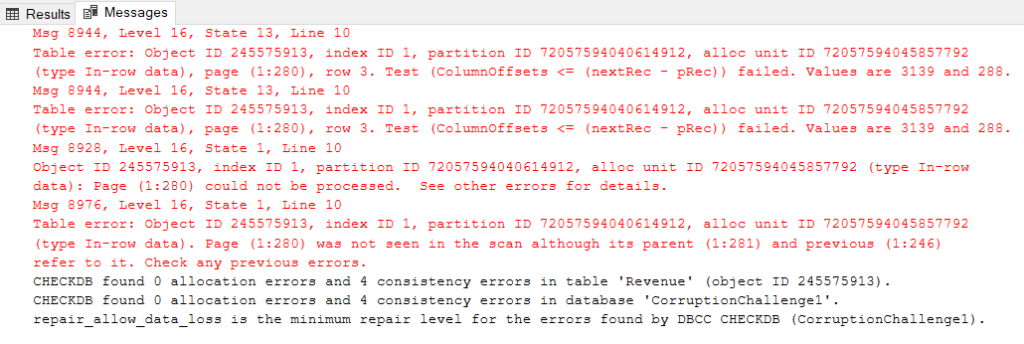When you hear checkdb repair_allow_data_loss it can sound like a good thing, but please read on, that is not at all true.
So, you have discovered CheckDB is reporting errors on your SQL Server database or on a table in your database.
When corruption strikes a SQL Server database, deciding on the right repair approach is critical to restoring functionality while minimizing risks. Two common options in SQL Server’s DBCC CHECKDB command are REPAIR_REBUILD and REPAIR_ALLOW_DATA_LOSS. While both are designed to address database corruption, their methods and potential consequences differ significantly. Choosing between these options depends on the severity of the corruption and the availability of a reliable database backup.
The checkdb repair_allow_data_loss option is the most aggressive repair method available, designed to fix severe corruption by removing damaged portions of the database that cannot be repaired. While it can restore the database to a usable state, it does so at the cost of potentially losing data. On the other hand, REPAIR_REBUILD is a safer option that handles minor corruption issues like repairing non-clustered indexes and does not involve any risk of data loss.
Understanding when to use each option can save time and data in critical scenarios. The checkdb repair_allow_data_loss method should always be a last resort, used only when restoring from a backup is not possible. By contrast, REPAIR_REBUILD is suitable for less severe cases where corruption can be resolved without sacrificing data. Knowing the capabilities and limitations of these options is essential for maintaining the health and integrity of your SQL Server databases.
What do you do instead of CheckDB REPAIR_ALLOW_DATA_LOSS?
When you find corruption, CheckDB REPAIR_ALLOW_DATA_LOSS seems like and quick and easy fix right? But do you actually know what you’re doing?

Well, if you read the error messages you might see that repair_allow_data_loss is the minimum repair level for the errors found.
Before running DBCC CheckDB REPAIR_ALLOW_DATA_LOSS ask for help
Before running repair_allow_data_loss, please reach out to us!
>>> You could save yourself time and money! Schedule Your FREE 30 min consult!
We can provide options to repair you database that don’t involve throwing your data away. Schedule Consult Now
BEWARE!
This doesn’t mean it will fix your data. It just means it will throw away any pages with corruption on them.
If you were to run checkdb or check table with repair_allow_data_loss the SQL Server lies to you. It tells you “The error has been repaired”. With a statement like that I’d assume the corruption was repaired. But that’s not the case. The repair in this case means that SQL Server threw away the page with the corruption on it. It didn’t repair anything it just threw out the data. Don’t make the mistake many others have! Or contact us before you run it.
When considering repair_rebuild vs repair_allow_data_loss, it’s essential to understand their different purposes and the risks involved. REPAIR_REBUILD is a safe, non-destructive option used for minor repairs, such as rebuilding indexes or fixing simple consistency errors. It does not modify or remove actual data, making it the preferred choice for resolving manageable corruption issues without the risk of data loss. In contrast, REPAIR_ALLOW_DATA_LOSS is a more aggressive option used for severe corruption, where data itself is damaged and cannot be repaired. This method can restore a database to a usable state but does so by removing unrecoverable data, often resulting in data loss.
The decision between repair_rebuild vs repair_allow_data_loss depends on the severity of the corruption and the availability of recent backups. For issues that can be addressed with REPAIR_REBUILD, it’s always advisable to use this safer option first. However, in cases where the corruption is critical and impacts the data itself, REPAIR_ALLOW_DATA_LOSS may be the only available solution if a backup cannot be restored. It’s important to approach this option with caution, as the resulting database will need careful review to assess and mitigate the impact of lost data.
Ultimately, the choice of checkdb repair_rebuild vs checkdb repair_allow_data_loss comes down to balancing the need for immediate database recovery with the potential for data loss. Whenever possible, restoring from a verified backup remains the best practice, as it maintains data integrity and avoids the risks associated with repair commands. For situations where repair options are necessary, working with SQL Server experts can help you determine the most effective and least disruptive path forward.
More details here: https://stedmansolutions.com/2020/06/09/repair_allow_data_loss-example/
Contact us before running repair_allow_data_loss!
Related Links:
- REPAIR_ALLOW_DATA_LOSS example
- Corruption Repair Help from Stedman Solutions.
- Contact us if you need help. https://Stedman.us/30
More from Stedman Solutions:

Steve and the team at Stedman Solutions are here for all your SQL Server needs.
Contact us today for your free 30 minute consultation..
We are ready to help!
